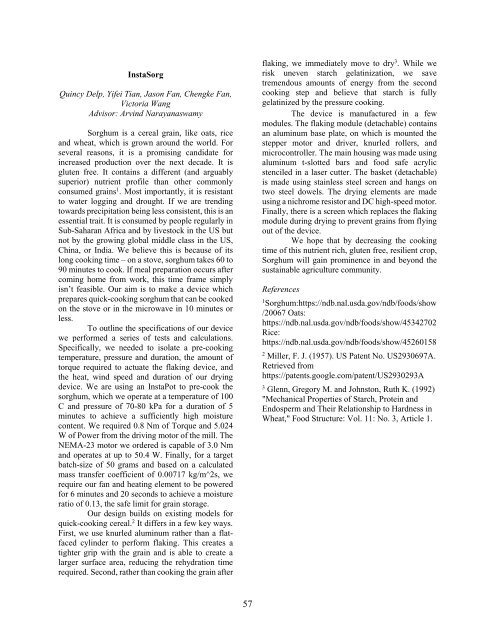Senior Design Expo 2019
The Senior Design Expo, held annually in May at Columbia University, is an opportunity for Columbia Engineering students to showcase what they have learned in their foundational math and science courses together with their engineering courses in innovative, creative, and purposeful designs and prototypes. Each year the Expo showcases more than 60 projects across all nine departments. Projects have included cutting-edge robotics, the New York City subway system, language technology, proposals for bridges to span the Hudson river, and much more.
The Senior Design Expo, held annually in May at Columbia University, is an opportunity for Columbia Engineering students to showcase what they have learned in their foundational math and science courses together with their engineering courses in innovative, creative, and purposeful designs and prototypes. Each year the Expo showcases more than 60 projects across all nine departments. Projects have included cutting-edge robotics, the New York City subway system, language technology, proposals for bridges to span the Hudson river, and much more.
Create successful ePaper yourself
Turn your PDF publications into a flip-book with our unique Google optimized e-Paper software.
InstaSorg<br />
Quincy Delp, Yifei Tian, Jason Fan, Chengke Fan,<br />
Victoria Wang<br />
Advisor: Arvind Narayanaswamy<br />
Sorghum is a cereal grain, like oats, rice<br />
and wheat, which is grown around the world. For<br />
several reasons, it is a promising candidate for<br />
increased production over the next decade. It is<br />
gluten free. It contains a different (and arguably<br />
superior) nutrient profile than other commonly<br />
consumed grains 1 . Most importantly, it is resistant<br />
to water logging and drought. If we are trending<br />
towards precipitation being less consistent, this is an<br />
essential trait. It is consumed by people regularly in<br />
Sub-Saharan Africa and by livestock in the US but<br />
not by the growing global middle class in the US,<br />
China, or India. We believe this is because of its<br />
long cooking time – on a stove, sorghum takes 60 to<br />
90 minutes to cook. If meal preparation occurs after<br />
coming home from work, this time frame simply<br />
isn’t feasible. Our aim is to make a device which<br />
prepares quick-cooking sorghum that can be cooked<br />
on the stove or in the microwave in 10 minutes or<br />
less.<br />
To outline the specifications of our device<br />
we performed a series of tests and calculations.<br />
Specifically, we needed to isolate a pre-cooking<br />
temperature, pressure and duration, the amount of<br />
torque required to actuate the flaking device, and<br />
the heat, wind speed and duration of our drying<br />
device. We are using an InstaPot to precook the<br />
sorghum, which we operate at a temperature of 100<br />
C and pressure of 70-80 kPa for a duration of 5<br />
minutes to achieve a sufficiently high moisture<br />
content. We required 0.8 Nm of Torque and 5.024<br />
W of Power from the driving motor of the mill. The<br />
NEMA-23 motor we ordered is capable of 3.0 Nm<br />
and operates at up to 50.4 W. Finally, for a target<br />
batch-size of 50 grams and based on a calculated<br />
mass transfer coefficient of 0.00717 kg/m^2s, we<br />
require our fan and heating element to be powered<br />
for 6 minutes and 20 seconds to achieve a moisture<br />
ratio of 0.13, the safe limit for grain storage.<br />
Our design builds on existing models for<br />
quick-cooking cereal. 2 It differs in a few key ways.<br />
First, we use knurled aluminum rather than a flatfaced<br />
cylinder to perform flaking. This creates a<br />
tighter grip with the grain and is able to create a<br />
larger surface area, reducing the rehydration time<br />
required. Second, rather than cooking the grain after<br />
flaking, we immediately move to dry 3 . While we<br />
risk uneven starch gelatinization, we save<br />
tremendous amounts of energy from the second<br />
cooking step and believe that starch is fully<br />
gelatinized by the pressure cooking.<br />
The device is manufactured in a few<br />
modules. The flaking module (detachable) contains<br />
an aluminum base plate, on which is mounted the<br />
stepper motor and driver, knurled rollers, and<br />
microcontroller. The main housing was made using<br />
aluminum t-slotted bars and food safe acrylic<br />
stenciled in a laser cutter. The basket (detachable)<br />
is made using stainless steel screen and hangs on<br />
two steel dowels. The drying elements are made<br />
using a nichrome resistor and DC high-speed motor.<br />
Finally, there is a screen which replaces the flaking<br />
module during drying to prevent grains from flying<br />
out of the device.<br />
We hope that by decreasing the cooking<br />
time of this nutrient rich, gluten free, resilient crop,<br />
Sorghum will gain prominence in and beyond the<br />
sustainable agriculture community.<br />
References<br />
1<br />
Sorghum:https://ndb.nal.usda.gov/ndb/foods/show<br />
/20067 Oats:<br />
https://ndb.nal.usda.gov/ndb/foods/show/45342702<br />
Rice:<br />
https://ndb.nal.usda.gov/ndb/foods/show/45260158<br />
2<br />
Miller, F. J. (1957). US Patent No. US2930697A.<br />
Retrieved from<br />
https://patents.google.com/patent/US2930293A<br />
3<br />
Glenn, Gregory M. and Johnston, Ruth K. (1992)<br />
"Mechanical Properties of Starch, Protein and<br />
Endosperm and Their Relationship to Hardness in<br />
Wheat," Food Structure: Vol. 11: No. 3, Article 1.<br />
57








